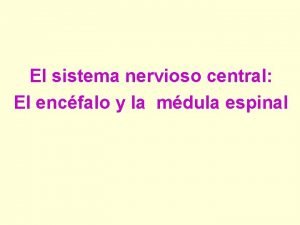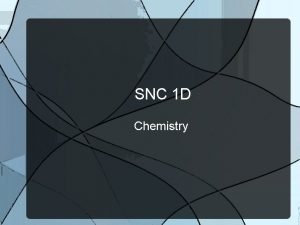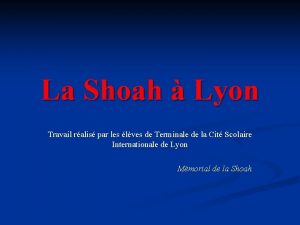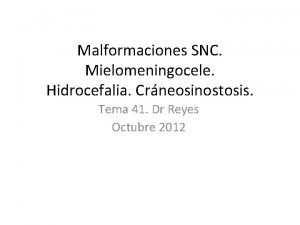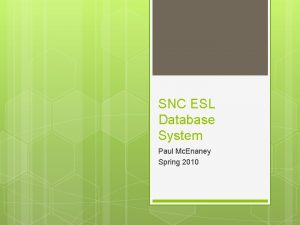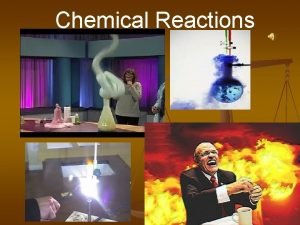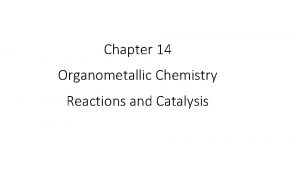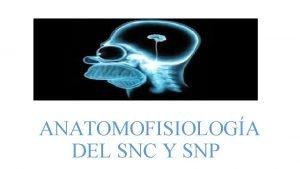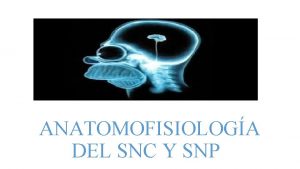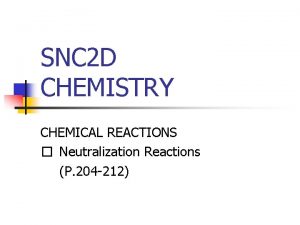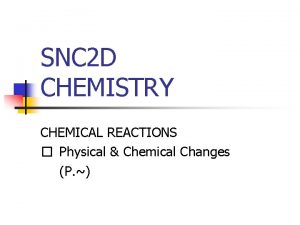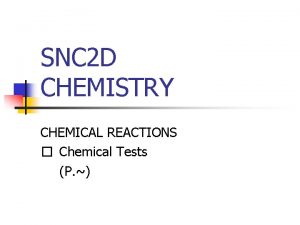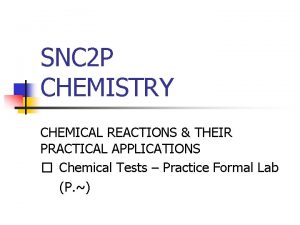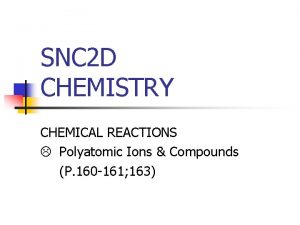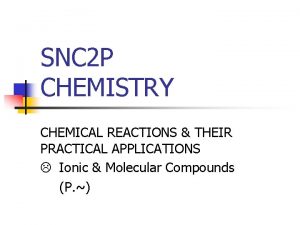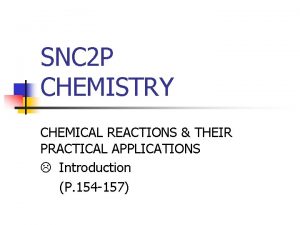SNC 2 D CHEMISTRY CHEMICAL REACTIONS Chemical Reactions






















- Slides: 22

SNC 2 D CHEMISTRY CHEMICAL REACTIONS � Chemical Reactions (P. 174 -175)

Chemical Reactions Chemical reactions may involve sophisticated chemicals, as in the explosive reaction of dynamite, or simple household materials, as in the reaction of a bathroom cleaner with a stain. They may occur constantly, as in the growth of your body, or occasionally, as in the changing colour of leaves in the fall. January 31, 2022 2 DCHEM - Chemical Reactions 1

Chemical Reactions In a chemical reaction, one or more substances change to produce new substances. Each starting substance in the reaction is called a reactant; each new substance formed is called a product. Because there are so many chemical reactions, it is important to have a clear and consistent way of describing them. For example, carbon + oxygen � carbon dioxide reactants January 31, 2022 2 DCHEM - Chemical Reactions products 2

Chemical Reactions For convenience, chemists use two types of equations to describe chemical reactions. In a word equation, names are used to represent each chemical. In a chemical equation, chemical formulas are used to represent each chemical. For example, when carbon (C) burns, it reacts with oxygen (O 2) to form carbon dioxide (CO 2). The equations for this reaction are: word equation: chemical equation: January 31, 2022 carbon + oxygen � carbon dioxide C (s) + O 2 (g) 2 DCHEM - Chemical Reactions � CO 2 (g) 3

Chemical Reactions NOTE! • word and chemical equations are always read from left to right, with the reactants located on the left and the products on the right • the arrow describes the direction of the reaction and is read “produces” • a plus sign between chemical symbols is read as “and” word equation: chemical equation: January 31, 2022 carbon + oxygen � carbon dioxide C (s) + O 2 (g) 2 DCHEM - Chemical Reactions � CO 2 (g) 4

Chemical Reactions NOTE! • the state of each substance is indicated by placing the appropriate symbol in brackets after the formula – (s) for solid, (l) for liquid, (g) for gas, and (aq) for solutions word equation: chemical equation: January 31, 2022 carbon + oxygen � carbon dioxide C (s) + O 2 (g) 2 DCHEM - Chemical Reactions � CO 2 (g) 5

Chemical Reactions For example, when pop is bottled, pressurized carbon dioxide is pumped into the pop. Some carbon dioxide reacts with water to produce carbonic acid. The (aq) state symbol tells you that carbonic acid is dissolved in water. Dissolved acids give pop its tart taste. word equation: chemical equation: January 31, 2022 carbon dioxide + water � carbonic acid CO 2 (g) + H 2 O (l) � 2 DCHEM - Chemical Reactions H 2 CO 3 (aq) 6

Chemical Reactions And when you open a bottle of pop, you release the pressure inside the bottle. This causes some carbonic acid molecules to break apart, releasing bubbles of carbon dioxide. The chemical reaction for this is the reverse of the one just discussed. word equation: chemical equation: January 31, 2022 carbonic acid � carbon dioxide + water H 2 CO 3 (aq) � CO 2 (g) 2 DCHEM - Chemical Reactions + H 2 O (l) 7

Chemical Reactions CHEMICAL REACTION v process in which substances (i. e. reactants) interact to produce new substances (i. e. products) with new properties v can be described using (i) a word equation or (ii) a chemical equation v letter in brackets after chemical formula indicates the state v for example, (i) carbon + oxygen � carbon dioxide reactants (ii) January 31, 2022 C (s) + products O 2 (g) � 2 DCHEM - Chemical Reactions CO 2 (g) 8

Chemical Reactions PRACTICE 1. Examine the following word equation: propane + oxygen � carbon dioxide + water (a) Name the reactant(s) in this reaction. (b) Name the product(s) in this reaction. (c) What is the purpose of the arrow in the word equation? (a) propane & oxygen (b) carbon dioxide & water (c) it points from the reactants to the products January 31, 2022 2 DCHEM - Chemical Reactions 9

Chemical Reactions PRACTICE 2. What information is provided in a chemical equation that is not provided in a word equation? state symbols – (s) for solid, (l) for liquid, (g) for gas, (aq) for solution January 31, 2022 2 DCHEM - Chemical Reactions 10

Chemical Reactions PRACTICE 3. Write word equations to represent the following chemical reactions: (a) Aluminum resists corrosion because it reacts with a gas found in air to form a protective coating of aluminum oxide. (a) aluminum + oxygen �aluminum oxide January 31, 2022 2 DCHEM - Chemical Reactions 11

Chemical Reactions PRACTICE 3. Write word equations to represent the following chemical reactions: (b) When aluminum foil is placed in a solution of copper(II) chloride, copper metal and another solution are formed. (b) aluminum + copper(II) chloride �copper + aluminum chloride January 31, 2022 2 DCHEM - Chemical Reactions 12

Chemical Reactions PRACTICE 3. Write word equations to represent the following chemical reactions: (c) When sodium sulphate and calcium chloride solutions are mixed, a precipitate of calcium sulphate and another substance is formed. (c) sodium sulphate + calcium chloride �calcium sulphate + sodium chloride January 31, 2022 2 DCHEM - Chemical Reactions 13

Chemical Reactions RECALL! Before we go much further you need to remember that some elements are made up of molecules that consist of a pair of atoms. These diatomic molecules were referred to as the “magnificent seven” since they form the shape of the number 7 in the periodic table. January 31, 2022 2 DCHEM - Chemical Reactions 14

�Check Your Learning 1. The following reaction shows how calcium carbonate (Ca. CO 3) is used to make calcium oxide, an important ingredient in cement: Ca. CO 3 (s) � Ca. O (s) + CO 2 (g) (a) Name the reactant(s) and the product(s). (b) Write the word equation for this reaction. (c) Name the gaseous product. (a) Rs = calcium carbonate Ps = calcium oxide & carbon dioxide (b) calcium carbonate �calcium oxide + carbon dioxide (c) carbon dioxide January 31, 2022 2 DCHEM - Chemical Reactions 15

�Check Your Learning 2. Consider this reaction: Ba. Cl 2 (aq) + Mg. SO 4 (aq) � Ba. SO 4 (s) + Mg. Cl 2 (aq) (a) Name the reactant(s) and the product(s). (b) Compare the states of the four chemicals. (c) Name the product that remains dissolved in water. (a) Rs = barium chloride & magnesium sulfate Ps = barium sulfate & magnesium chloride (b) three are in solution, one is a solid (c) magnesium chloride January 31, 2022 2 DCHEM - Chemical Reactions 16

�Check Your Learning 3. Write the word equations for the following reactions: (a) Ca. Cl 2 and Na 2 SO 4 react to form Ca. SO 4 and Na. Cl. (a) calcium chloride + sodium sulphate �calcium sulphate + sodium chloride January 31, 2022 2 DCHEM - Chemical Reactions 17

�Check Your Learning 3. Write the word equations for the following reactions: (b) Ba. CO 3 reacts when heated to produce Ba. O and CO 2. (b) barium carbonate �barium oxide + carbon dioxide January 31, 2022 2 DCHEM - Chemical Reactions 18

�Check Your Learning 3. Write the word equations for the following reactions: (c) Ag. NO 3 reacts with KCl to produce Ag. Cl and KNO 3. (c) silver nitrate + potassium chloride �silver chloride + potassium nitrate January 31, 2022 2 DCHEM - Chemical Reactions 19

�Check Your Learning 4. nitrate solution, a furry deposit of silver metal forms on the coil. The solution also turns blue as a copper (II) nitrate solution forms. Write the word and chemical equation for this reaction. copper + silver nitrate �silver + copper (II) nitrate Cu + Ag. NO 3 �Ag + Cu(NO 3)2 January 31, 2022 2 DCHEM - Chemical Reactions 20

�Check Your Learning TEXTBOOK P. 175 Q. 1, 2, 5 P. 241 Read “The Bombardier Beetle”; Answer Q. 1 January 31, 2022 2 DCHEM - Chemical Reactions 21
 Section 2 classifying chemical reactions worksheet answers
Section 2 classifying chemical reactions worksheet answers Section 2 classifying chemical reactions worksheet answers
Section 2 classifying chemical reactions worksheet answers Unit 5 chemical reactions answers
Unit 5 chemical reactions answers Types of reactions
Types of reactions Chemical equations and reactions chapter 8 review
Chemical equations and reactions chapter 8 review Section 1 atoms elements and compounds
Section 1 atoms elements and compounds Chapter 6 section 1 atoms elements and compounds answer key
Chapter 6 section 1 atoms elements and compounds answer key Skeleton hand whmis
Skeleton hand whmis Snc y snp diferencias
Snc y snp diferencias Water density
Water density Snc lajaa venissieux
Snc lajaa venissieux Snc società
Snc società Craneorraquisis
Craneorraquisis Paul mcenaney
Paul mcenaney Section 1 chemical changes
Section 1 chemical changes Are kc and kp equal
Are kc and kp equal How to write a balanced redox reaction
How to write a balanced redox reaction 4 types of chemical reactions
4 types of chemical reactions 5 types of reactions chemistry
5 types of reactions chemistry Type of reactions chemistry
Type of reactions chemistry Synthesis and combustion reaction
Synthesis and combustion reaction Slidetodoc.com
Slidetodoc.com Functional groups ib chemistry
Functional groups ib chemistry








